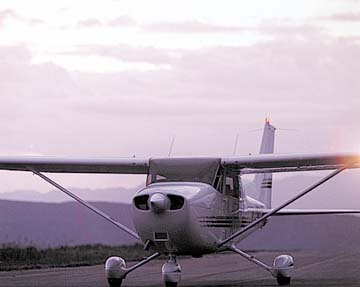

"GET-HOME-IT'S"
A significant cause of accidents in the United States is the strong desire to reach a destination. Better known to pilots as "get-home-itis," it is a serious, yet curable, contamination of the normally clear-thinking brain cells
|
The following story happened to a pilot while on a very long cross-country flight. It was a cold and windy night. (Isn't that how most mysteries start?) The pilot and his family (spouse and two children) were traveling from Los Angeles, CA, to join the rest of the family in Springfield, IL, for the holidays. Weather was good during the entire route of flight, which was to have taken 14-15 hours initially. The pilot decided to spread out the flight over two days. He had planned several fuel stops. Somewhere over Texas one of the children got sick. Not your garden variety of air sickness but something closely resembling the flu. The pilot's line of thinking was that, when they arrived at their destination, medical assistance could be obtained for the ill child. Darkness was rapidly approaching, and the pilot was flying into unknown territory. It became darker and darker. As a matter of fact, the night was the darkest the pilot had ever seen. Being accustomed to seeing at least some lights in the distance or on the horizon, the pilot became temporarily disoriented. Naturally, the child took that time to become sicker and sicker. Regaining a semblance of spatial orientation, the pilot started to look for a suitable airport, one fairly close to medical assistance. By now the little plane had crossed into Oklahoma proceeding northeast. Looking at the area chart the pilot found that the nearest large airport was quite a distance from the route of flight. |
 |
Fuel was getting low and the pilot didn't see the airport, which had pilot-controlled lighting, where he had planned to refuel. Certain that he had overflown the airport, the pilot used radio navigation to return to where the airport should have been. No airport lights were to be seen on the field. How could the lights be turned on? The pilot looked at the Airport/Facility Directory and used the directions to key the mike. But no lights went on anywhere. The pilot was getting concerned. And the child's condition was getting worse by the minute.
On the pilot flew. Occasionally a small group of lights would appear off in the distance. But there was no airport. The pilot decided that--discretion being the better part of valor--a call to approach control in Springfield, IL, would be a wise idea. Approach control was trying to locate the small airplane on radar, when, as destiny would have it, the engine sputtered. Just a little sputter, like the calm before the storm. Then the engine quit all together. Landing the airplane was a sure bet now. However, no option was given as to where.
The luck of the Irish was with the pilot, however, because right below the plane was a strip--smack in the middle of nowhere. By now both children were sick, one sicker than the other, and the pilot's spouse was furious. The plane finally landed. Radio contact from the ground to approach control was unsuccessful, so they spent the night on the small strip right in the middle of Nowhere, USA.
This story has a happy ending. The pilot got fuel the next day and, after explaining what happened to the proper authorities, the family was on their way for the remainder of the trip, which was uneventful. Incidentally, that was the last time the family ever flew together. The pilot flew home alone and the rest of the family took an air carrier. Imagine that.
This pilot was fortunate. The plane landed safely and no one was hurt. But the pilot had pushed to get to the destination, even though the situation was looking grim earlier in the flight. Remaining the night in a populated area would have been the best decision. Why do pilots let ego and "gethomeitis" get in the way of good judgment?
Remember--nothing is as important as your safety. Nothing at all.
| ŠAvStop Online Magazine Contact Us Return Home |